post posterity / remnants of the future * was bleibt, ist was wir bleiben lassen * what will be is what we let be
pictures below:
east_west (flags), part of the exhibition project post posterity / what will be is what we let be, 2014, installation view at Karlskaserne Ludwigsburg, vintage camping stools (both from the former GDR and FRG)
deutsch: Abbildungen unten:
ost_west (Flaggen), Teil des Ausstellungsprojekts post posterity / was bleibt, ist was wir bleiben lassen, 2014, Installationsansicht in der Karlskaserne Ludwigsburg, antike Klapphocker (DDR - BRD)
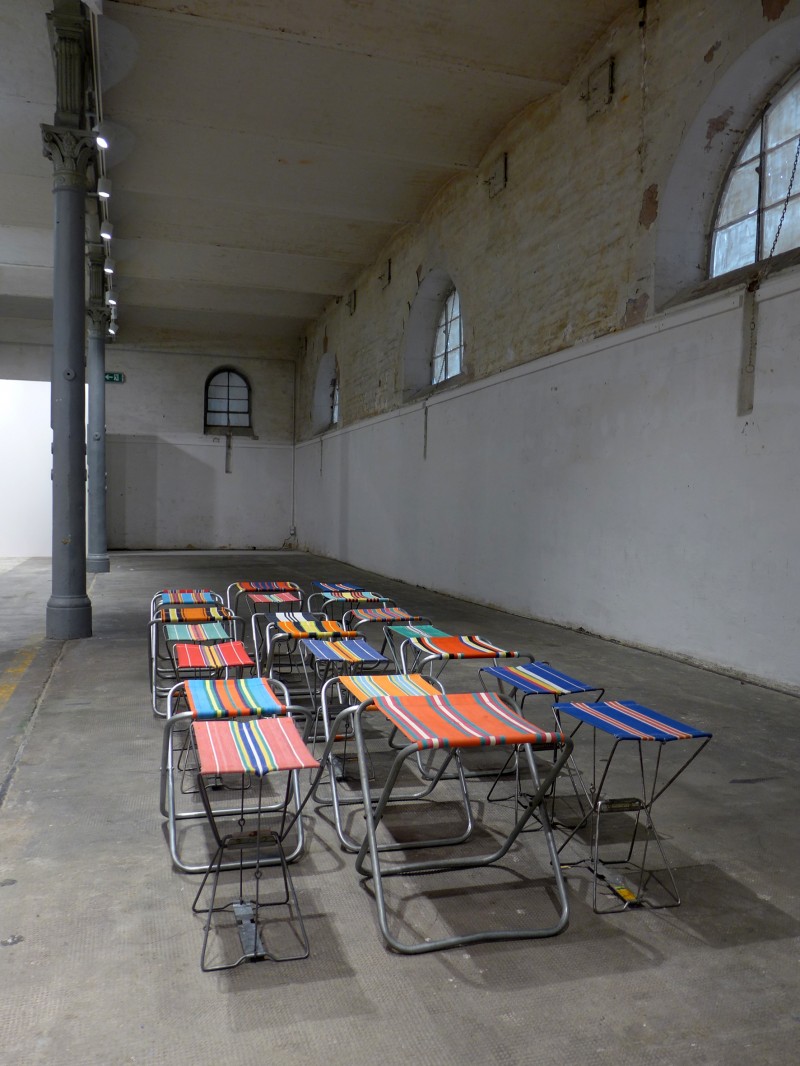
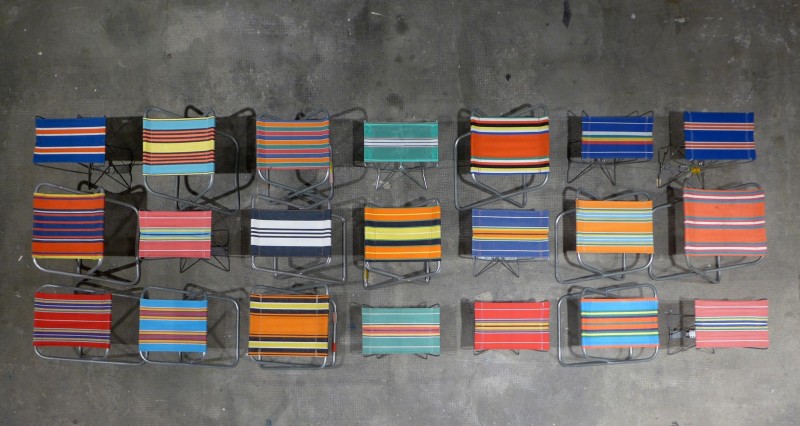
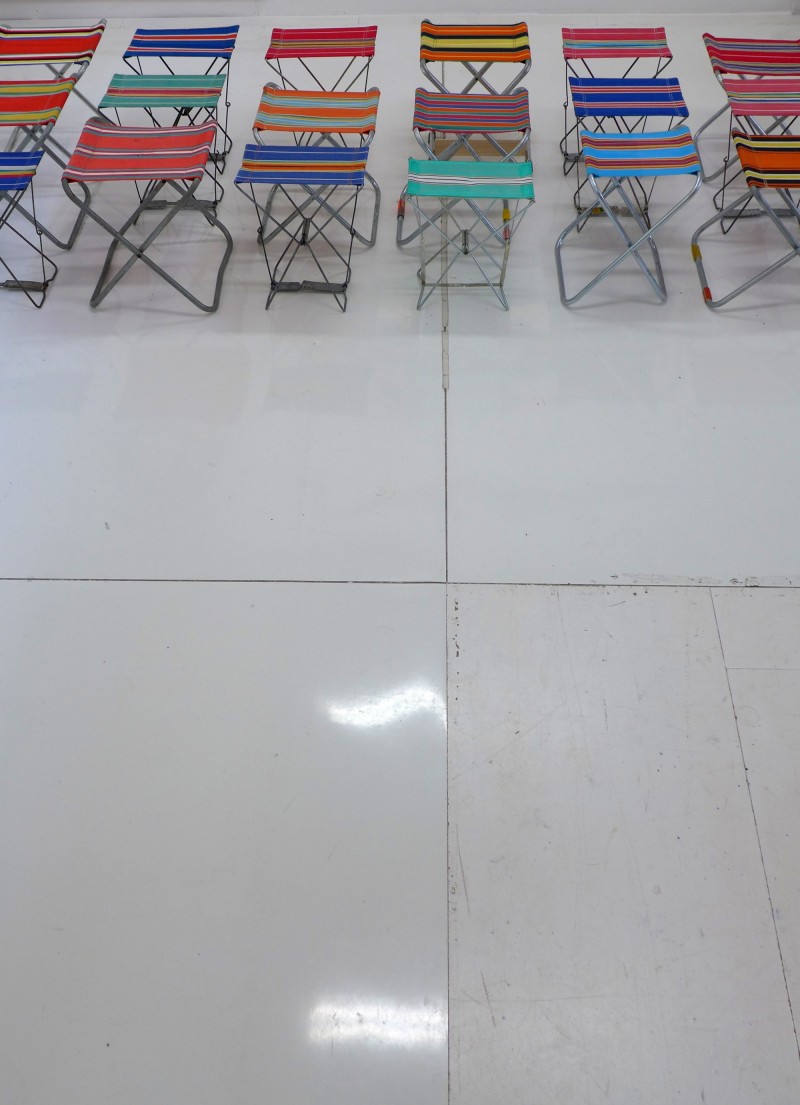
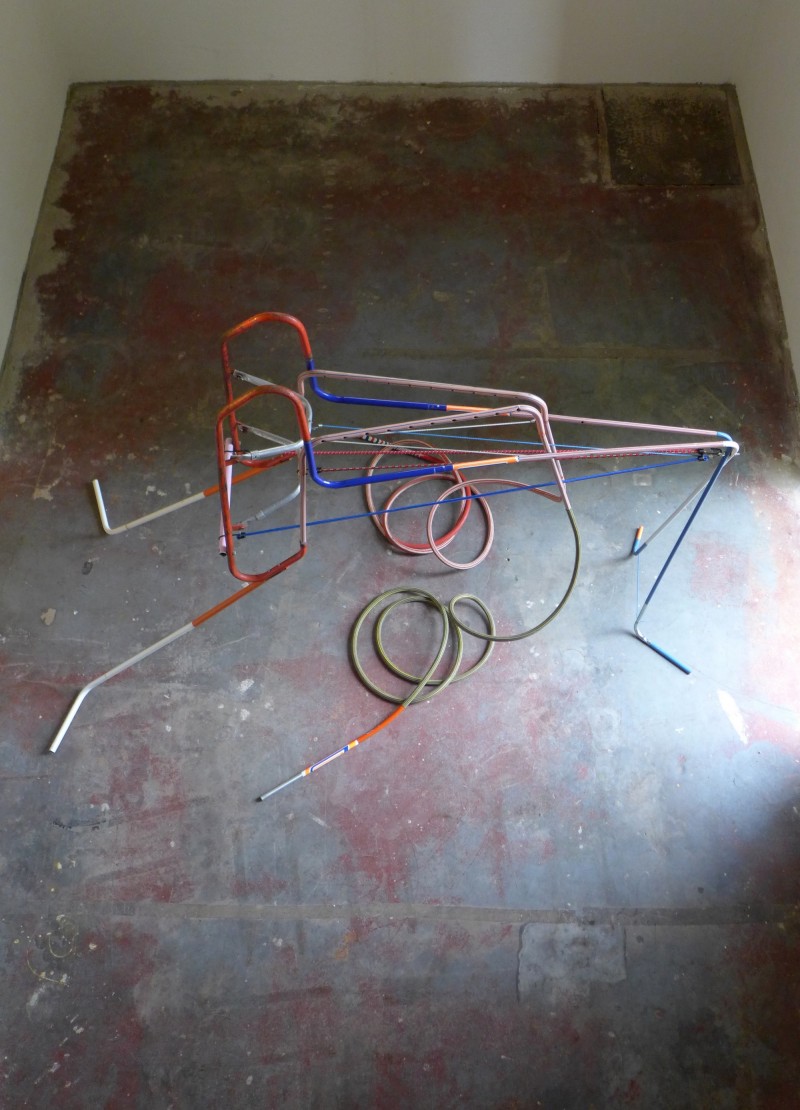
homeward (heimwärts / hacia casa), installation at Karlskaserne Ludwigsburg, 2015

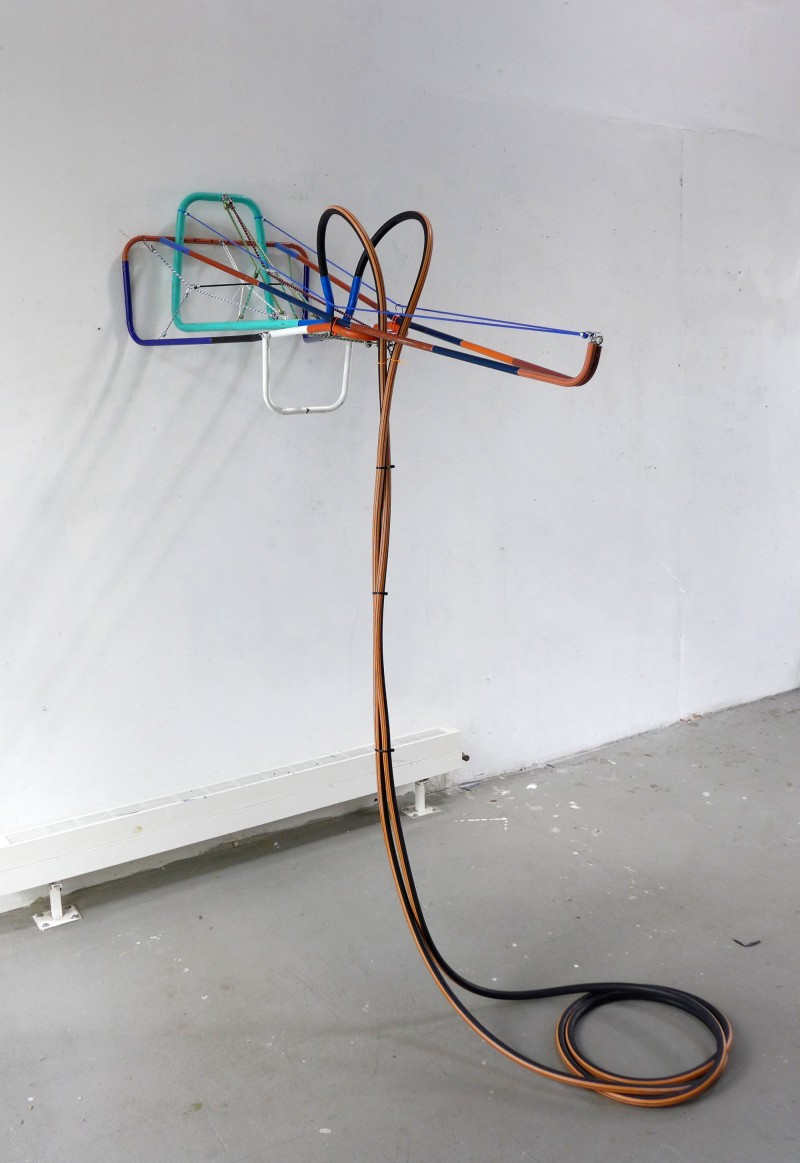
Amaru, 2016
Eisen, Blech, Aluminium, Plastik, Lack, Gummi
220 x 62 x 175 cm
im Besitz der Daimler Kunstsammlung
Das schwebend Vertikale des Objekts mit eleganter Art Nouveau-Drehung zum Boden hin ist eine denkbare Lesart von vielen: Die Arbeit lässt sich variantenreich stellen, hängen oder legen, erinnert an Gefährt, Behältnis, Apparat, Maschine, Roboter, Trophäe, Chimäre, Insekt. Sie ist variable Wand- und Bodenarbeit zugleich und lässt sich - nicht nur gedanklich - bewegen und verändern.
Der Titel der Arbeit, vorsichtig aus präkolumbischer Mythologie entlehnt, legt auch eine mögliche metaphysische Sicht auf das installative Kunstwerk nahe. Innnerhalb der andinischen Kosmovision ist Amaru ein Mittler zwischen Himmel, einer realen äußeren und einer tiefinneren Welt, der Erdmutter und somit auch zwischen den Elementen Luft, Wasser und Erde.
Für Landauer stellt der nachträglich gefundene Titel für sein Kunstwerk eine glückliche Fügung dar, denn das Kunstwerk geht über einen rein ästhetischen, spielerischen Umgang mit vorgefundenen und veränderten Materialien und Formen, mit Design, Architektur und Skulptur hinaus, um sich komplexeren Inhalten zu nähern, die an existenzielle Fragen rühren.
Das Leben spendende Fabelwesen Amaru, das in seiner äußeren Gestalt dem altweltlichen Phönix ähnelt, meint auch tatsächlich jenen Wiedergänger aus der Asche, der dem vergangenen, dem Untergang geweihten Material, in übertragenem Sinn, neues Leben einzuhauchen vermag. Diese archaischen Metaphern liefern ideale Denkanstöße, um Form und Inhalt des Objekts zu deuten. Doch Landauer gräbt hier möglicherweise auch in Autobiografischem: Sucht er eigene Mythen auf? Sucht er Verbindung zu den Ahnen und den verlorenen Orten der eigenen Kindheit, den urgroßväterlichen und großväterlichen Farmen in Ecuador und Bolivien? Ist die Odyssee der in der Nachkriegszeit nach Südamerika ausgewanderten Familie der Mutter und die daraus entstandene kulturelle Prägung des Künstlers präsent in solch einem Werk? Für Landauer ist sein Vehikel in jedem Fall auch ein Symbol, um Spirituelles anzudeuten, anzudenken, umzulenken und einzufangen. Das schamanistische Moment, das diesem Objekt innezuwohnen scheint, wirkt wie ein unbeabsichtigtes, beinahe naives Greifenwollen nach Jenseitigem.
Hinweise auf ausrangierte fragmentierte Alltagsgegenstände, Zerstörung und Material-Neuinterpretation liefern die plausiblen Konnotationen, um das Kunstwerk auch sachlicher deuten zu können. Metamorphosen sind seit einigen Jahren zentrale Thematik bei Landauer. Die Materialien durchlaufen sozusagen Stadien der Zerstörung, um schließlich als transmutierte Wesen, vom Urmaterial emanzipiert, in Existenz zu treten.
Darüber hinaus aber staut sich viel Immaterielles an in Schläuchen und Rohren, das sich zu befreien sucht. Eine harmonisch schwingende Symmetrie verdichtet sich an ihrem dynamischsten Ende zu einer paradoxen Form. Ein in sich geschlossener Kreislauf verweist hier auf eine Spirale des Immergleichen: Anstatt sich zu teilen wird der Schlauch zur Falle, zum sich selbst zerstörenden Metabolismus, zu einem nur vermeintlich autonomen Körper. Es ist dieser Figur nicht möglich, sich auf Dauer selbst zu versorgen – ohne das Äußere muss das Innere verkümmern. Es gibt keine Autarkie ohne Kommunikation, ohne Hinwendung zum Gegenüber, keinen Output ohne Input. Geist und Körper bedingen sich.
Es wird fassbarer, was das Kunstwerk auch meinen könnte: In äußerlich wirkende Funktionslosigkeit gebannt – und der vierten Dimension beraubt – muss sich die Apparatur als geistiges Wesen behaupten, ihren Körper überwinden – und dies gelingt ausschließlich innerhalb der Gedanken ihres Betrachters.
Renate Wiehager
The almost floating horizontal movement of the object with its elegant Art Nouveau turn towards the ground is only one of many possible ways to read this work of art: it is variable, it can be hung or layed, it is reminiscent of a vehicle, a container, an apparatus, a machine, a robot, a trophy, a chimera, an insect. It could be a wall or a floor work at the same time and can be moved and altered in several ways.
The title of the work is carefully borrowed from pre-Columbian mythology and also suggests a possible metaphysical view of the installative artwork. In the Andean cosmovision, Amaru is a mediator between heaven and Mother Earth, representing a real outer and a deep inner world. Thus, he also mediates between the elements air, water and earth.
For Landauer, the subsequently found title represents a lucky coincidence for his sculpture. The work of art goes beyond a purely aesthetic playful use of found and altered materials and forms and his use of design, architecture and sculpture towards an approach to more complex contents that prompt existential questions.
The life-giving mythical creature Amaru, whose appearance resembles the Old World Phoenix, actually represents this revenant from the ashes, who is figuratively capable of breathing new life into the past, doomed material. These archaic metaphors provide ideal food for thought to interpret form and content of the object.
But Landauer may be digging in his own biography: Is he looking for his own myths? Is he trying to make contact to the ancestors and lost places of his own childhood, his great-grandfather's and grandfather's farms in Ecuador and Bolivia? Is the maternal family’s odyssee, who migrated to South America in the post-war period, and the resultant cultural impact on the artist present in this work? In any case, for Landauer, his vehicle is also a symbol to indicate, contemplate, divert and to capture spiritual matters. The shamanistic moment seemingly innate in this object seems like an unintentional, almost naive hold of the otherworldly.
The evidence of discarded and fragmented everyday objects, destruction and material reinterpretation provide the plausible connotations to be able to interpret the work of art more factually. Metamorphoses have been a central motif for Landauer for several years. The materials, so to speak, undergo stages of destruction to finally become transmutated beings, which are emancipated from the original material, and come into existence on their own behalf.
In addition, however, a lot of immaterial substance accumulates in hoses and pipes trying to liberate itself. A harmonically oscillating symmetry condenses at its most dynamic end into a paradoxical form. A self-contained cycle refers to a spiral of the never changing: Instead of splitting, the tube becomes a trap, a self-destroying metabolism, a supposedly autonomous being. It is impossible to permanently provide for yourself. Without the outside, the inside is bound to wither away. There is no autarky without communication, without turning to the other, no output without input. Mind and body are mutually dependent.
The meaning of the artwork is getting more comprehensible: transfixed in what seems to be a lack of function - and deprived of the fourth dimension - the apparatus must assert itself as a spiritual being and overcome its own body. This only comes into effect within the mind of the observer.
Renate Wiehager